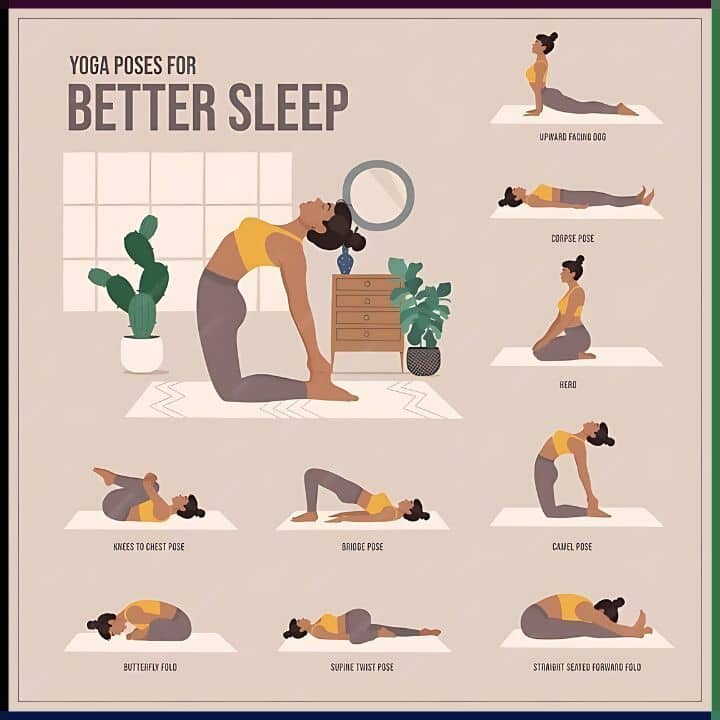Yoga Poses for Better Sleep: A Comprehensive Guide to Restful Nights
In today’s fast-paced world, getting a good night’s sleep can be a challenge. Stress, anxiety, and the constant buzz of technology often interfere with our ability to unwind and rest properly. Fortunately, yoga offers a natural and effective way to improve sleep quality. In this article, we’ll explore a variety of yoga poses specifically designed to promote better sleep. Whether you’re a seasoned yogi or a beginner, these poses can help you relax, release tension, and prepare your body and mind for a restful night.
Why Yoga for Sleep?
Yoga is a holistic practice that combines physical postures, breathing exercises, and meditation. It has been shown to reduce stress, lower blood pressure, and improve overall well-being. When it comes to sleep, yoga can help by:
- Reducing Stress and Anxiety: Yoga encourages mindfulness and deep breathing, which can calm the nervous system and reduce stress hormones.
- Relieving Physical Tension: Gentle stretches and poses can release muscle tension, making it easier to relax.
- Improving Circulation: Certain poses enhance blood flow, which can help regulate sleep patterns.
- Promoting Relaxation: Yoga helps activate the parasympathetic nervous system, which is responsible for rest and digestion.
Yoga Poses for Better Sleep
Let’s dive into some of the best yoga poses for improving sleep quality. Remember to move slowly and mindfully, focusing on your breath. If you’re new to yoga, consider using props like yoga blocks or a bolster to support your body.
1. Child’s Pose (Balasana)
Child’s Pose is a gentle, restorative pose that helps calm the mind and relieve tension in the back, shoulders, and neck.
- How to Do It: Kneel on the floor, touch your big toes together, and sit on your heels. Separate your knees about hip-width apart. Exhale and lay your torso down between your thighs. Extend your arms forward with palms facing down. Rest your forehead on the mat.
- Benefits: This pose stretches the lower back and hips, promoting relaxation and stress relief.
2. Legs-Up-The-Wall Pose (Viparita Karani)
This pose is excellent for relieving tired legs and feet, improving circulation, and calming the mind.
- How to Do It: Sit close to a wall and swing your legs up so that your heels rest against the wall. Lie back and extend your arms out to the sides, palms facing up. Close your eyes and breathe deeply.
- Benefits: It helps reduce swelling in the legs, calms the nervous system, and prepares the body for sleep.
3. Reclining Bound Angle Pose (Supta Baddha Konasana)
This restorative pose opens the hips and chest, promoting deep relaxation.
- How to Do It: Lie on your back and bring the soles of your feet together, letting your knees fall open to the sides. Place a bolster or pillow under your knees for support. Rest your arms at your sides, palms facing up.
- Benefits: It helps release tension in the hips and groin, and encourages deep breathing.
4. Supine Twist Pose (Supta Matsyendrasana)
Twists are great for releasing tension in the spine and improving digestion, which can contribute to better sleep.
- How to Do It: Lie on your back and draw your knees into your chest. Extend your arms out to the sides, palms facing down. Drop both knees to one side while keeping your shoulders flat on the mat. Turn your head in the opposite direction of your knees. Hold for a few breaths, then switch sides.
- Benefits: This pose stretches the spine, shoulders, and hips, and helps relieve lower back pain.
5. Corpse Pose (Savasana)
Savasana is the ultimate relaxation pose, often used at the end of yoga practice to integrate the benefits of the session.
- How to Do It: Lie flat on your back with your legs extended and arms at your sides, palms facing up. Close your eyes and focus on your breath. Allow your body to completely relax.
- Benefits: It promotes deep relaxation, reduces stress, and prepares the body for sleep.
6. Seated Forward Bend (Paschimottanasana)
This pose stretches the spine and hamstrings, helping to release tension in the back and legs.
- How to Do It: Sit with your legs extended in front of you. Inhale and lengthen your spine, then exhale and fold forward from the hips. Reach for your feet or shins, keeping your back straight.
- Benefits: It calms the mind, relieves stress, and stretches the lower back and hamstrings.
7. Cat-Cow Pose (Marjaryasana-Bitilasana)
This gentle flow between two poses helps to release tension in the spine and improve flexibility.
- How to Do It: Start on your hands and knees in a tabletop position. Inhale as you arch your back (Cow Pose), lifting your head and tailbone. Exhale as you round your spine (Cat Pose), tucking your chin to your chest.
- Benefits: It increases spinal flexibility, relieves tension in the back, and promotes relaxation.
8. Standing Forward Bend (Uttanasana)
This pose helps to calm the mind and relieve tension in the back and hamstrings.
- How to Do It: Stand with your feet hip-width apart. Exhale and fold forward from the hips, letting your head hang. Bend your knees slightly if needed. Let your arms hang or hold opposite elbows.
- Benefits: It stretches the hamstrings, calves, and hips, and promotes relaxation.
Tips for a Successful Yoga Practice Before Bed
- Create a Calm Environment: Dim the lights, play soft music, and ensure your space is comfortable and quiet.
- Focus on Your Breath: Deep, slow breathing helps activate the parasympathetic nervous system, promoting relaxation.
- Be Consistent: Try to practice yoga at the same time each night to establish a routine.
- Listen to Your Body: Avoid pushing yourself too hard. Yoga before bed should be gentle and relaxing.
Conclusion
Incorporating yoga into your nightly routine can significantly improve your sleep quality. By practicing these poses regularly, you can reduce stress, release physical tension, and create a sense of calm that prepares your body and mind for restful sleep. Remember, consistency is key, so make yoga a regular part of your bedtime ritual. Sweet dreams!










